OFF-TOPIC (14)
By:
February 6, 2020
Off-Topic brings you over-the-transom, on-tangent essays, dialogues and subjective scholarship on an occasional, impulsive basis. This time, an attempt to learn the lessons of what we’re never taught…
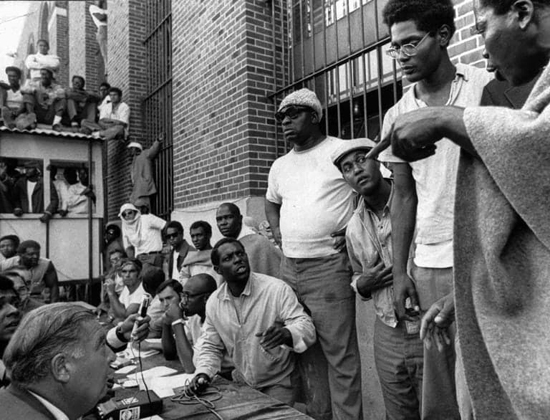
History is erased by the winners. The truest heroes get no monuments, but their shadow has already been cast. Sometimes, though, it may not fall for decades. Many Americans are so used to combat being out of sight, that when it comes right to our doorstep it remains outside our visible spectrum. Few Americans remember, or even noticed at the time, when a Philadelphia mayor dropped a bomb on the headquarters of a dissident group and took out an entire city block in 1985; to many Americans it was national news, a century after the fact, when the Watchmen TV-series centered on the militarized white-supremacist rampage that obliterated the self-determined Black community of Tulsa in 1921. By the time that story was told, the country seemed uncommonly ready to listen to it. Maybe we’ll be ready to listen to Big Black’s story too.
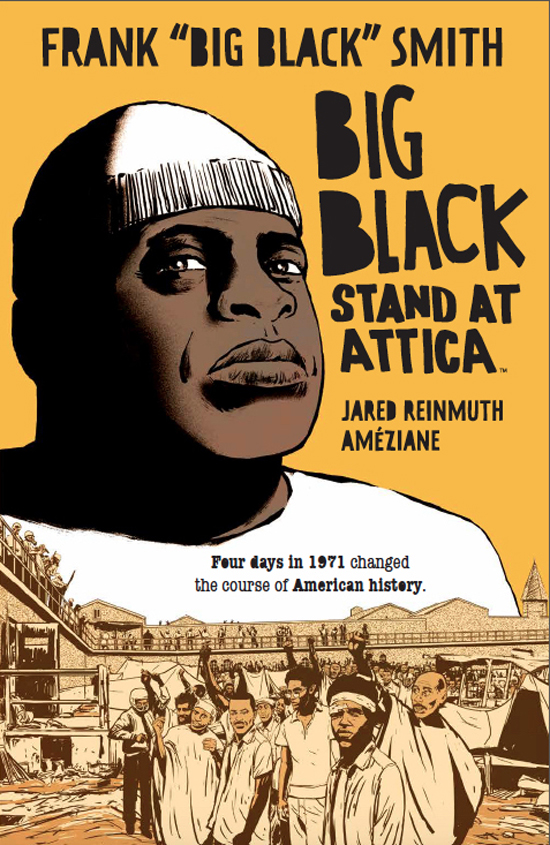
As with Watchmen, the truth may come by way of a comic book, seeping in through popular narrative the way that official accounts seldom allow. The Attica Uprising was neither erased like Tulsa nor ignored like Philly; the state of New York tried to bury it with lies, litigation, division and doubt. In 1971, human-rights violations at the prison in Attica, NY had grown so unendurable that inmates rebelled, taking over the site and demanding reforms; the standoff became a battleground in the culture-war of racial inequality and the competing agendas of liberation and authority, and the conflict ended when Governor Nelson Rockefeller sent in NY State Troopers to massacre indiscriminately. But the story of Frank “Big Black” Smith — and the ordeal of Attica for him and others — was far from over.
A former highschool football hero and military drill sergeant, Smith was partway into a 15-year sentence for a first offense (ineptly holding up a local drug-dealer’s dice game) at the maximum-security Attica fortress when the prisoners rose up. A natural leader and fatherly figure, he’d been football coach for the inmates and then was chosen as the rebellion’s chief of security, making sure that no one came to harm and that the guards and staff who’d been taken as hostages were treated well. He kept activists and officials safe as they came in and out to negotiate with the prisoners — until the Governor’s troops moved in, killing over 40 inmates, hostages and staffers. Big Black was then beaten and tortured at length by guards in reprisal, while the state claimed (and the media amplified) that hostages who’d been shot multiple times by troops had had their throats slashed, or in one case been castrated, by inmates — and tried to discredit the medical examiner who found (and announced) otherwise. Black survived, and made parole two years later; testified (unsuccessfully) against Rockefeller’s appointment as Vice President; and in a unanimous jury verdict was awarded the largest damages of all time ($4 million) in a suit against the state (which was set aside). In the meantime he had become a drug counselor (kicking his own addiction), an advocate for his fellow survivors and other prisoners, as well as surviving hostages and the families of killed guards who’d been lied to and silenced by the state, and an investigator for defense attorneys. He had nightmares and PTSD for the rest of his life, and met the love of it, Pearl Battle Smith, marrying in 1983; he died of cancer in 2004.
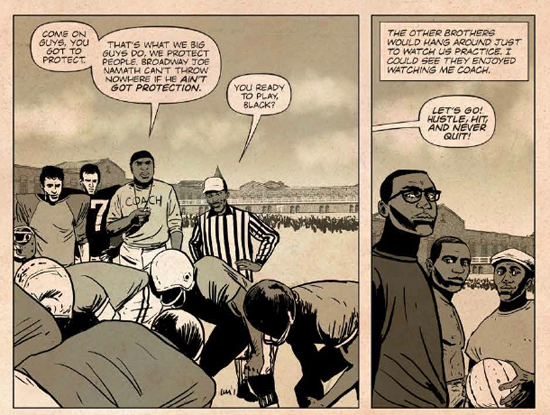
Which is where his story begins again, and is told in full for the first time, in Big Black: Stand at Attica, a graphic novel debuting February 18th of this year, written by Frank and Jared Reinmuth, and drawn by Améziane (from Archaia/BOOM! Studios). This is partially Reinmuth’s life-story too; his stepdad, Dan Meyers, was an attorney in the “Attica Brothers”’ 26-year class-action suit against New York; Reinmuth started assisting the case in his youth and, in 1997, interviewing Big Black. The two got the idea to work Black’s oral autobiography into a movie, to show America what it hadn’t been told; the book’s creative consultant, comic-scholar and convention-organizer Patrick Kennedy, convinced Reinmuth that “A movie costs 50 million; we can make a graphic novel for 50K.” When Stand at Attica was still a screenplay, Kennedy told me, “Jared wrote the original draft while Black was fighting cancer”; he did not live to see the book come out or know that there would be one, but “Black’s wife Pearl read the original screenplay to him on his deathbed.” Now both the story, and in some ways Frank Smith, have been reborn.
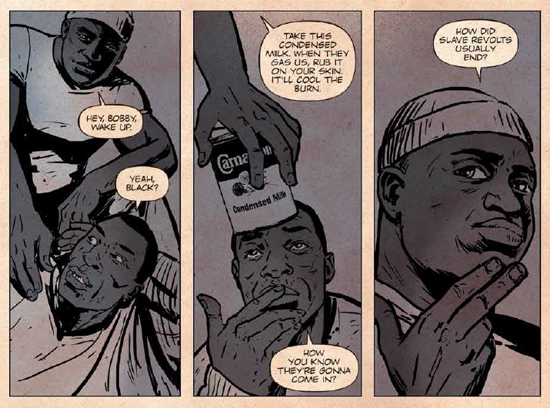
Big Black: Stand at Attica is the pop-cultural milestone of 2020, an astounding work of psychological biography and people’s journalism. Black and Reinmuth’s text has an ear for honest speech and authentic moments that’s supernaturally clear, and the art by Améziane (a French creator known for bio-comics of other African American heroes Muhammad Ali and Angela Davis) has a style and structure that looks like an old newspaper page come to life and enacting a truer story. Reinmuth’s script moves with Black’s memories, starting with the atrocity at the center of his life and circling through his promising start, rough upbringing and later triumphs, the life-lessons flashing back and monstrous suffering stabbing through with the random rhythm of trauma (and redemption); the scene shifting between home, hell, and halls of power like lost libraries sifted through. On pages with the tone and texture of yellowed newsprint, “Amé”’s art puts us in the midst of the events — and the characters’ psyches — with utter immediacy. His expressionist use of emotional coloring and photojournalistic specificity of rendering portray the reality of a man, a community and a nation’s existential ordeal in a way that is unsparingly horrifying and impossible to turn away from — you need to get through this with Big Black, and live to know what it meant.
Kennedy brought me together with Reinmuth and Amé to discuss what it was like to spend time with this story — and it was as if Big Black were in the room too. To my astonishment, this trans-oceanic skype talk was the first time that scriptwriter and artist had ever spoken…
AMÉZIANE: So many comic teams never meet. I remember, 100 Bullets, Azzarello & Risso, for three years, never spoke to each other. And I always wondered, how could they do that.
REINMUTH: We did exactly that!
AMÉZIANE: Two years apart, it was magical, I was amazed it could be possible. To be close and never talk to each other.
REINMUTH: Things that I had maybe edited out, or I thought I wanted to add to the script but I just [could] not quite [fit] in, Amé magically came up with these things, completely independent of me, and put them in. I think specifically of that scene, the “White Power!” scene [in which this cry goes up from a crowd outside the prison], that comes from the Kuntsler documentary [William Kuntsler: Disturbing the Universe, about one of the Attica Brothers’ legendary lawyers]. I had wanted to include it but never really felt like I had found exactly where; all of a sudden one day, he’s like, “Hey, I found this image that I really feel is powerful and I’d love to use,” and I was like, “You gotta be kidding me, I wanted to do that; okay, let’s figure it out and put it in.” Things like that, just kismet all over the place, so when I say this guy is my other brother, he truly is.
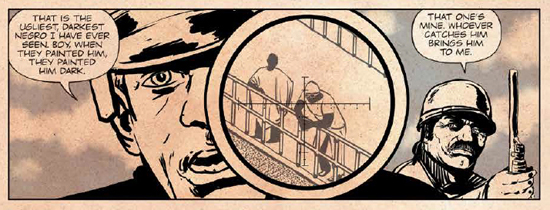
HILOBROW: Jared, what changes did you make to the structure of the storytelling, shifting from screenplay to graphic novel?
REINMUTH: First of all you have the person who, number one, came up with the idea of envisioning it as a graphic novel, realizing it as a graphic novel: Patrick, who looked at me one day and said, “I know you have your heart set on a film, but we could get this made as a graphic novel, and then we can make a film.” I could not sleep that night, I knew he was so right. And he put me through the paces, and he turned me on to some great graphic novels. Like Coward, from Ed Brubaker & Sean Phillips… because of that, I allowed myself to add the Big Black character-voice into the script; it had never been with that first-person commentary. And when I was doing that, when I was reading those comics, I realized that I had to go back and just bring everything I remembered that Big Black said.
HILOBROW: When the book starts we’re right in the traumatic aftermath of the uprising; these are all things that recur, more in sequence, later on — you may have been guided by the priority these things had in Big Black’s own mind…
REINMUTH: I think honestly, the first thing I ever learned about Attica, with Big Black, was that image of him on the table [being tortured], I always thought of that moment of him, clinging to life, as he’s fighting for his life, and he’s holding on for his life, and — how does he do it, how does he get out of that moment? And [how do we] give you a safe way to take you through the story — and he was a person that always made you feel safe — and then go back and give this biography, which is a truly American biography. So many of the hallmarks of the African American experience; being born in a cotton field with no medical care, the son of a sharecropper, no birth certificate. Coming up, migrating to the North, getting involved in the criminal justice system very early, and then growing the sense of conscience through that.
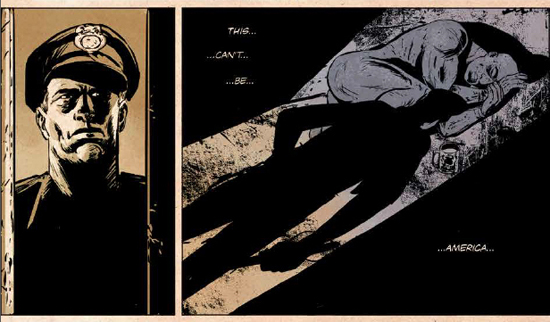
HILOBROW: We’ve talked about the magic of what it was like for you and Amé to collaborate, what was it like for you and Big Black to collaborate?
REINMUTH: Again, an amazing story. I met when him I was about 10 years old, and he was of course just a hero to everyone in our family. When I went to assist my stepdad during the trial, in 1997, he had just gotten his $4 million judgment. And so we thought for sure it would be a Hollywood thing, and he asked me if I would write down his words, so he would have something to shop around, and hopefully maintain some control over that side of things. So we used to ride around during the day, go to soul food restaurants in Buffalo, and then I would go back to my hotel room, and I would write, and then I would go to his hotel room, and I would read it — I mean I’ll never forget the first time, he just got this faraway look in his eyes and he looked like he was transported. And I was scared to even speak, of course, and all of a sudden he looks at me and he goes [using Jared’s childhood nickname], “Damn it, Joey! You got all that?!” It was one of the proudest moments of my life.
HILOBROW: I’m interested that it was he who envisioned this as a possible movie, so obviously he was conscious of media and what media can do — did he have a sense that the best way to get this story told at that point was through dramatization?
REINMUTH: Yes. He was also of the oral tradition; you’d just be mesmerized as he spoke. And he did realize, he was such a fan of movies. Believe it or not he was a huge fan of the Western; he loved Shane. It just made sense that it had to have some art in it, that’s the way he told his stories, and that’s what he was thinking.
We assumed that someone in Hollywood would be like “Hey, this is great, give this to me and I’ll make it into a screenplay.” And I couldn’t get people to read it, I couldn’t get the momentum that I got once we started the graphic novel. With Amé already beginning to pump out pages, then people really could see it, but for some reason [before], they just wouldn’t take the time to read it.
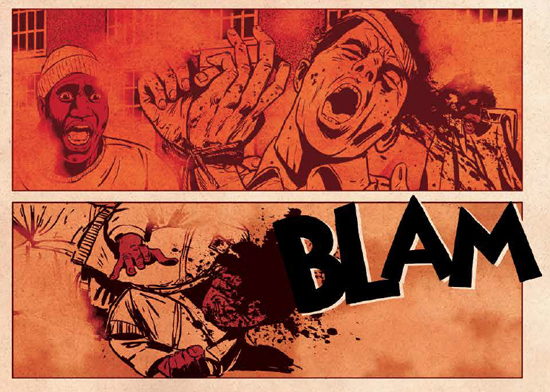
AMÉZIANE: This guy did what he had to do, and suffered like many others [before him], and many more [after], and never backed down. That’s why it’s called “Stand at Attica.” That’s what Big Black did. That’s something I respect profoundly. And I wanted to try to give the reader the maximum proximity to him, to show the maximum of him I could. And thank god there was a voiceover in the book, so I had many thoughts I could dramatize; I could show him at different times of his life. It helps, because when he suffers, I tried to make us suffer with him, because it was a very hard story. [On jobs in the past], what I said to my friends was always, “Eh, it’s not hard to draw, it’s not like a prison riot.” And the first thing Jared proposed to me to do? A prison riot! I opened the story, and this guy is tortured in the yard, naked, spread-eagled, and when I saw that I said, “We will never get a publisher.” This was hardcore, at the beginning. So I tried not to tame it down, because Jared said, “We will do it all the way.” And we suffered for that — we had to make it hard for us to do it, too. We can’t take the easy way, and I don’t believe we did.
HILOBROW: Not at all, it feels like you’re experiencing it yourself as the reader. We know Jared’s very personal background in this story; was there anything about your own background that drew you to, or moved you to identify with it? Or is it just more like, Big Black’s bravery is the kind of thing that can move anyone?
AMÉZIANE: I like the ’70s for many reasons, but one of the most is the political rising of the minorities. At that time, minorities could [claim] the right to be able to say, “You can’t treat me like that anymore.” And that’s very close to my story. I’m of Italian background from my mother, my father is Algerian. So, in France, I’m not really one of the “Frenchmen,” I’ve got not one drop of French blood. I’m always in the middle. I’m a Mediterranean guy, part African, part European, [it’s] always awkward to see where I can stand. I saw racism — for me, it’s “You’re a White guy, why do you feel racism?” But the other White guys don’t feel me as a White guy, they always feel me as something different. So it was in one sense, racism by default: “you are different, I will treat you different.” What I experience is one-tenth of what other people can feel, but that one-tenth gives me the [courage] to say, “When I am an artist, I have a microphone, I can tell what I want.” I can tell about space-opera, I can tell about spandex-guys, or I can tell about something that’s close to me. I like to have fun, I like to do thrillers and crime stories, but most of my work now is political, historical stuff, because it’s the life of real people.
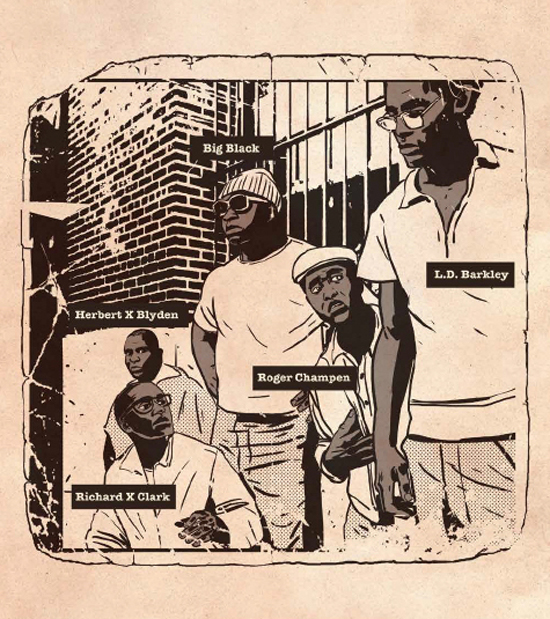
HILOBROW: Jared, in the graphic novel you print what the prisoners’ demands in the Attica uprising were; when I looked up the demands of the 2018 national prison strike they were depressingly similar, which makes you think how little has changed. Do you think that a book like this can help change things, or is it more a matter of, there are missing pieces in the stories that this country tells itself, and the role that this book can play is filling out Americans’ understanding of their own country?
REINMUTH: It’s my firm hope that we’re all able to jump into this conversation and bring this sensibility. What I wanted was to give prisoners a role model in Big Black, that they could see themselves [in], today. And realize that he was where they are, and they are where he was, and we’re gonna find a way forward somehow. We have to. We cannot continue mass incarceration. Mass incarceration, as I think everyone on our side of it understands, is just the extension of Jim Crow, the extension of slavery, and we’re abolitionists. I think we’re all abolitionists; I can only speak for myself, but, and that’s why in the dedication I say “that this book may inspire a spirit of abolition.” That is my firm hope; that we give inspiration, and maybe even some comfort to people who suffer in this horrifying system.
[Stay aware of Stand at Attica through its Facebook, Twitter and Instagram accounts]
MORE POSTS by ADAM McGOVERN: OFF-TOPIC (2019–2025 monthly) | textshow (2018 quarterly) | PANEL ZERO (comics-related Q&As, 2018 monthly) | THIS: (2016–2017 weekly) | PEOPLE YOU MEET IN HELL, a 5-part series about characters in McGovern’s and Paolo Leandri’s comic Nightworld | Two IDORU JONES comics by McGovern and Paolo Leandri | BOWIEOLOGY: Celebrating 50 years of Bowie | ODD ABSURDUM: How Felix invented the 21st century self | CROM YOUR ENTHUSIASM: C.L. Moore’s JIREL OF JOIRY stories | KERN YOUR ENTHUSIASM: Data 70 | HERC YOUR ENTHUSIASM: “Freedom” | KIRK YOUR ENTHUSIASM: Captain Camelot | KIRB YOUR ENTHUSIASM: Full Fathom Five | A 5-part series on Jack Kirby’s Fourth World mythos | Reviews of Annie Nocenti’s comics Katana, Catwoman, Klarion, and Green Arrow | The curated series FANCHILD | To see all of Adam’s posts, including HiLo Hero items on Lilli Carré, Judy Garland, Wally Wood, and others: CLICK HERE
